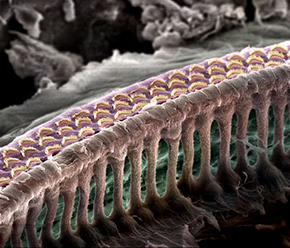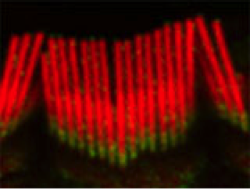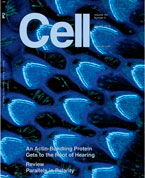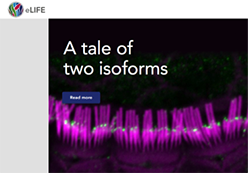Selected Publications
Adeyemo A, Faridi R, Chattaraj P, Yousaf R, Tona R, Okorie S, Bharadwaj T, Nouel-Saied LM, Acharya A, Schrauwen I, Morell RJ, Leal SM, Friedman TB, Griffith AJ, Roux I. Genomic analysis of childhood hearing loss in the Yoruba population of Nigeria. Eur J Hum Genet. 2021 Nov 26. doi: 10.1038/s41431-021-00984-w. Epub ahead of print. PMID: 34837038.
Sethna S, Zein WM, Riaz S, Giese AP, Schultz JM, Duncan T, Hufnagel RB, Brewer CC, Griffith AJ, Redmond TM, Riazuddin S, Friedman TB, Ahmed ZM. Proposed therapy, developed in a Pcdh15-deficient mouse, for progressive loss of vision in human Usher syndrome. Elife. 2021 Nov 9;10:e67361. doi: 10.7554/eLife.67361. PMID: 34751129; PMCID: PMC8577840.
Katsuno T, Belyantseva I, Cartagena-Rivera AX, Ohta K, Crump SM, Petralia RS, Ono K, Tona R, Imtiaz A, Rehman A, Kiyonari H, Kaneko M, Wang Y-X, Abe T, Ikeya M, Fenollar-Ferrer C, Riordan GP, Wilson EA, Fitzgerald TS, Segawa K, Omori K, Ito J, Frolenkov GI, Friedman TB, Kitajiri S-I. TRIOBP-5 sculpts stereocilia rootlets and stiffens supporting cells enabling hearing. JCI Insight. 2019 June 20.

Cover of JCI Insight, 20 June 2019. Source: Inna Belyantseva, M.D, Ph.D., NIDCD
Rehman AU, Santos-Cortez RL, Morell RJ, Drummond MC, Ito T, Lee K, Khan AA, Basra MA, Wasif N, Ayub M, Ali RA, Raza SI, University of Washington Center for Mendelian Genomics, Nickerson DA, Shendure J, Bamshad M, Riazuddin S, Billington N, Khan SN, Friedman PL, Griffith AJ, Ahmad W, Riazuddin S, Leal SM, Friedman TB. (2014) Mutations in TBC1D24, a gene associated with epilepsy, also cause nonsyndromic deafness DFNB86. Am J Hum Genet 2014 Jan 2;94(1):144-52. doi: 10.1016/j.ajhg.2013.12.004.

Graphic representation of TBC1D24 structure (left) and its encoded protein (right). DFNB86-associated mutations are shown above the diagram, and epilepsy-associated mutations are shown below.
Riazuddin S, Belyantseva, IA, Giese APJ., Kwanghyuk L, Indzhyukulian AA, Nandamuri SP, Yousaf R, Sinha GP, Lee S, Terrell D, Hegde RS, Ali RA, Anwar S, Andre-Elizondo PB, Sirmaci A, Parise LV, Basit S, Wali A, Ayub M, Ansar M, Ahmad W, Khan S, Akram J, Tekin M, Riazuddin Sh, Cook T, Buschbeck EK, Frolenkov G, Leal SM, Friedman TB, Ahmed ZM. (2012) Alterations of the CIB2 calcium-and integrin-binding protein cause Usher syndrome type 1J and nonsyndromic deafness DFNB4. Nature Genetics Volume 44: pages 1265-1271.
Rehman AU, Morell, RJ, Khan SY, Belyantseva IA, Boger ET, Shahzad M, Ahmed ZA, Riazuddin S, Khan SN, Friedman TB (2010) Targeted capture and next-generation sequencing identifies C9orf75, encoding TAPERIN, as the mutated gene in nonsyndromic deafness DFNB79. The American Journal of Human Genetics 86: 378-388.

Localization of TAPERIN at the base
(taper) of hair cell stereocilia in the mouse
inner ear. The American Journal of
Human Genetics 2010
Borck G, Rehman AU, Lee K, Pogoda, H-M, Kakar N, von Ameln S, Grillet N, Hildebrand MS, Ahmed ZM, Nürnberg G, Ansar M, Basit S, Javed Q,. Morell RJ, Nasreen NA, Shearer AE, Ahmad A, Kahrizi K, Shaikh RS, RA A, Khan SN, Goebel I, Meyer NC, Kimberling WJ, Webster JA, Stephan D, Schiller M, Bahlo M, Najmabadi H, Gillespie PG, Nürnberg P, Wollnik B, Riazuddin S, Smith RJH, Ahmad W, Müller U, Hammerschmidt M, Friedman TB, Riazuddin S, Leal SM, Ahmad J, Kubisch C (2011) Loss-of-Function Mutations of ILDR1 Cause Autosomal-Recessive Hearing Impairment DFNB42. The American Journal of Human Genetics 88: 1-11.
Kitajiri S, Sakamoto T, Belyantseva IA, Goodyear RJ, Stepanyan R, Fujiwara I, Bird JE, Riazuddin S, Ahmed ZM, Hinshaw JE, Sellers J, Bartles JR, Hammer JA, Richardson GP, Griffith AJ, Frolenkov GI, Friedman TB. Actin-Bundling Protein TRIOBP Forms Resilient Rootlets of Hair Cell Stereocilia Essential for Hearing. Cell, Volume 141, Issue 5, 786-798, 28 May 2010.

Cover of Cell May 2010








